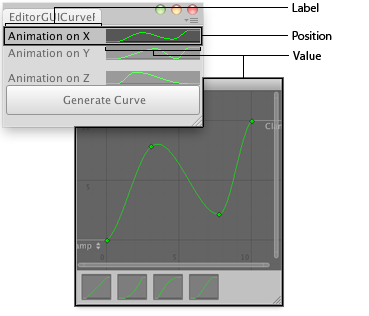public static function CurveField(position:
Rect,
label: string,
value: AnimationCurve):
AnimationCurve;
public static function CurveField(position:
Rect,
label: GUIContent,
value: AnimationCurve):
AnimationCurve;
public static function CurveField(position:
Rect,
value: AnimationCurve,
color: Color,
ranges: Rect):
AnimationCurve;
public static AnimationCurve CurveField(Rect position,
AnimationCurve value,
Color color,
Rect ranges);
public static function CurveField(position:
Rect,
label: string,
value: AnimationCurve,
color: Color,
ranges: Rect):
AnimationCurve;
public static AnimationCurve CurveField(Rect position,
string label,
AnimationCurve value,
Color color,
Rect ranges);
public static function CurveField(position:
Rect,
label: GUIContent,
value: AnimationCurve,
color: Color,
ranges: Rect):
AnimationCurve;
public static AnimationCurve CurveField(Rect position,
GUIContent label,
AnimationCurve value,
Color color,
Rect ranges);
Parameters
| position | Rectangle on the screen to use for the field. |
| label | Optional label to display in front of the field. |
| value | The curve to edit. |
| color | The color to show the curve with. |
| ranges | Optional rectangle that the curve is restrained within. |
Returns
AnimationCurve The curve edited by the user.
Description
Make a field for editing an AnimationCurve.

Curve field in an Editor Window.
#pragma strict
// Makes the selected GameObject follow the animation curve. // // Usage: Generate the curves for X,Y and Z axis of your desired GameObject // Select a GameObject and click Generate Curve. // Press Play and see your object moving. // Note that this is an Editor script.
class EditorGUICurveField extends EditorWindow {
var curveX : AnimationCurve = AnimationCurve.Linear(0,0,1,0); var curveY : AnimationCurve = AnimationCurve.Linear(0,0,1,1); var curveZ : AnimationCurve = AnimationCurve.Linear(0,0,1,0);
@MenuItem("Examples/Create Curve For Object") static function Init() { var window = GetWindow(EditorGUICurveField); window.position = Rect(0,0,400,199); window.Show(); }
function OnGUI() { curveX = EditorGUI.CurveField( Rect(3,3,position.width-6,50), "Animation on X", curveX); curveY = EditorGUI.CurveField( Rect(3,56,position.width-6,50), "Animation on Y", curveY); curveZ = EditorGUI.CurveField( Rect(3,109,position.width-6,50), "Animation on Z", curveZ);
if(GUI.Button(Rect(3,163,position.width-6,30),"Generate Curve")) AddCurveToSelectedGameObject(); }
// A GameObject with the FollowAnimationCurve script must be selected function AddCurveToSelectedGameObject() { if(Selection.activeGameObject) { var comp : FollowAnimationCurve = Selection.activeGameObject.GetComponent.<FollowAnimationCurve>(); comp.SetCurves(curveX, curveY, curveZ); } else { Debug.LogError("No Game Object selected for adding an animation curve"); } } }
using System.Collections; using System.Collections.Generic; using UnityEngine; using UnityEditor;
public class EditorGUICurveField : EditorWindow { AnimationCurve curveX = AnimationCurve.Linear(0, 0, 1, 0); AnimationCurve curveY = AnimationCurve.Linear(0, 0, 1, 1); AnimationCurve curveZ = AnimationCurve.Linear(0, 0, 1, 0);
[MenuItem("Examples/Curve Field demo")] static void Init() { EditorWindow window = GetWindow(typeof(EditorGUICurveField)); window.position = new Rect(0, 0, 400, 199); window.Show(); }
void OnGUI() { curveX = EditorGUI.CurveField( new Rect(3, 3, position.width - 6, 50), "Animation on X", curveX); curveY = EditorGUI.CurveField( new Rect(3, 56, position.width - 6, 50), "Animation on Y", curveY); curveZ = EditorGUI.CurveField( new Rect(3, 109, position.width - 6, 50), "Animation on Z", curveZ);
if (GUI.Button(new Rect(3, 163, position.width - 6, 30), "Generate Curve")) AddCurveToSelectedGameObject(); }
// A GameObject with the FollowAnimationCurve script must be selected void AddCurveToSelectedGameObject() { if (Selection.activeGameObject) { FollowAnimationCurve comp = Selection.activeGameObject.GetComponent<FollowAnimationCurve>(); comp.SetCurves(curveX, curveY, curveZ); } else { Debug.LogError("No Game Object selected for adding an animation curve"); } } }
This is the run-time script which animates the attached GameObject:
#pragma strict
// This script is called by the editor script. // It must not be in the Editor folder. // Also it needs to be called FollowAnimationCurve.js for the // the editor script to call the SetCurves() function.
var curveX : AnimationCurve; var curveY : AnimationCurve; var curveZ : AnimationCurve;
function SetCurves(xC : AnimationCurve, yC : AnimationCurve, zC : AnimationCurve) { curveX = xC; curveY = yC; curveZ = zC; }
function Update() { transform.position = Vector3(curveX.Evaluate(Time.time), curveY.Evaluate(Time.time), curveZ.Evaluate(Time.time)); }
// Note that this must be FollowAnimationCurve.cs
using UnityEngine; using System.Collections;
public class FollowAnimationCurve : MonoBehaviour { public AnimationCurve curveX; public AnimationCurve curveY; public AnimationCurve curveZ;
public void SetCurves(AnimationCurve xC, AnimationCurve yC, AnimationCurve zC) { curveX = xC; curveY = yC; curveZ = zC; }
void Update() { transform.position = new Vector3( curveX.Evaluate(Time.time), curveY.Evaluate(Time.time), curveZ.Evaluate(Time.time)); } }
public static function CurveField(position:
Rect,
property: SerializedProperty,
color: Color,
ranges: Rect):
void;
public static void CurveField(Rect position,
SerializedProperty property,
Color color,
Rect ranges);
public static function CurveField(position:
Rect,
property: SerializedProperty,
color: Color,
ranges: Rect,
label: GUIContent):
void;
public static void CurveField(Rect position,
SerializedProperty property,
Color color,
Rect ranges,
GUIContent label);
Parameters
| position | Rectangle on the screen to use for the field. |
| property | The curve to edit. |
| color | The color to show the curve with. |
| ranges | Optional rectangle that the curve is restrained within. |
| label | Optional label to display in front of the field. Pass [[GUIContent.none] to hide the label. |
Description
Make a field for editing an AnimationCurve.
Did you find this page useful? Please give it a rating: